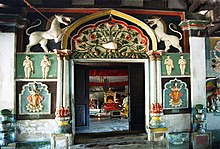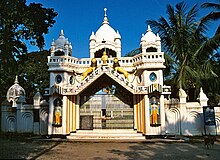


Satra are institutional centers associated with the Ekasarana tradition of Vaishnavism, largely found in the Indian state of Assam and neighboring regions.[1][2] Numbering in the hundreds, these centers are generally independent of each other and under the control of individual adhikara (or satradhikar), though they can be grouped into four different Sanghati (orders).
These centers, in the minimum, maintain a prayer house (Namghar, or Kirtan-ghar), initiate lay people into the Ekasarana tradition and include them as disciples of the satra from whom taxes and other religious duties are extracted. The Neo-Vaishnavite satra culture started in the 16th century. They grew rapidly in the 17th century and patronage extended to them by first the Koch kingdom and later the Ahom kingdom was crucial in the spread of the Ekasarana religion.[3] Many of the larger Satras house hundreds of celibate and non-celibate bhakat (monks), hold vast lands and are repositories of religious and cultural relics and artifacts. The satra extend control over their lay disciples via village namghar. Satra in which the principal preceptors lived, or which preserve some of their relics are also called thaan.[4]
Another satra was established by king Samudrapal at a place known as Yogihati in the same period (1232 CE) as evident from a stone inscription found in Ambari.[5] The neo-Vaishnavite satras were established by Assamese Vaishnavite monasteries for religious practices at the initiative of the Ahom Kings of Assam in the middle of the 17th century[web 1] to propagate neo Vaishnavism.[web 2][web 3] Sankaradeva is said to have established his first Satra at Bordowa, his birthplace, and then in different places of Assam.[web 4][web 5][6]
Through initially the satras were started as a part of the egalitarian movement of Eksarana Dharma, they later turned into a place of orthodoxy. From the early 20th century, the authority and orthodoxy of the Satras have been challenged by reform movements, most notably under the Sankar Sangha. The Satras coordinate some of their activities via the Asam Satra Mahasabha, an umbrella organization of all the Satras. According to the Mahasabha's count on its website there is altogether a total of 862 Satras including the satras present in both the states of Assam and West Bengal.[web 6]
- ^ (Dubey 1978, pp. 189–193)
- ^ Sarma 1966.
- ^ (Sarma 1966, pp. 23–24)
- ^ (Sarma 1966, p. 101)
- ^ "The inscription has recorded that Samudrapala who was like the Sun God had this sattra establishment within his jurisdiction, in which rituals were performed and was attached to the royal residence, the inmates of the sattra being the yogis or siddhas, residing at a particular spot called YogihatT. The inscription is dated Saka 1154 (A.D. 1232) and was composed by one Mudha." (PDF). Archived (PDF) from the original on 11 June 2020. Retrieved 25 May 2020.
- ^ (Chakravarty 1989, p. 4)
Cite error: There are <ref group=web> tags on this page, but the references will not show without a {{reflist|group=web}} template (see the help page).